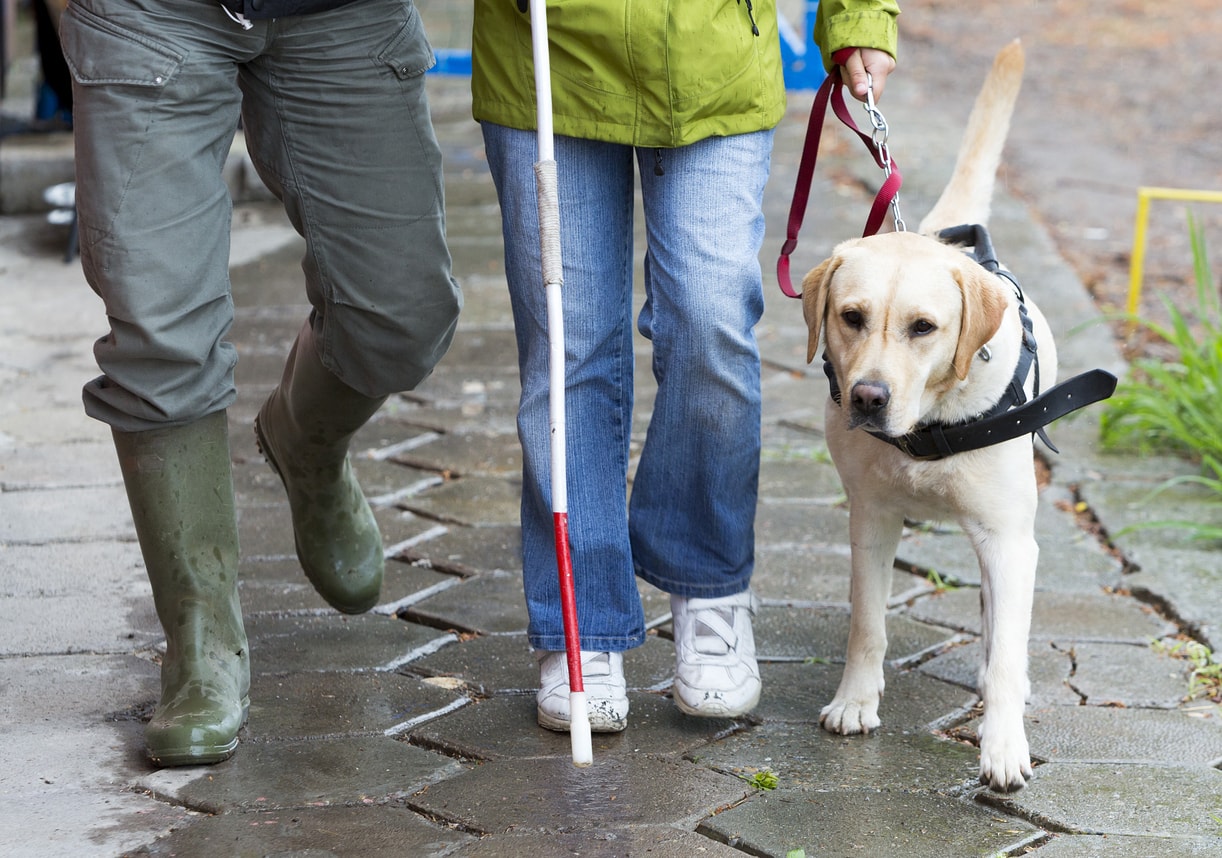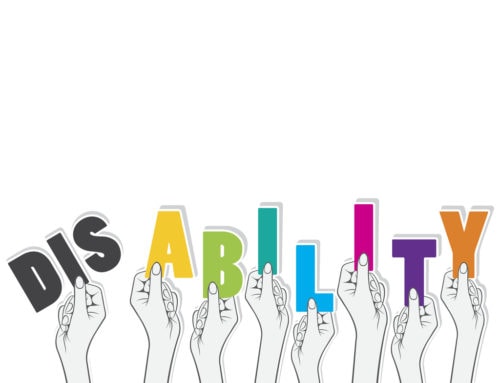service animal: an animal trained to perform specific tasks for a disabled person; not an “emotional support animal” (ESA), which is a pet that provides comfort or emotional support to the owner and may not be trained.
*** TROVELOG ***
It is estimated that service dogs have existed since around 13,000 B.C., for many purposes — performing domestic tasks, or assisting in law enforcement and combat situations. Today, they help people with disabilities participate in their communities and government. They have proven their invaluable place among mankind throughout the world. It is beyond dispute that they are indeed man’s best friend.
But still there remains great misunderstanding about, discrimination against, and hostility toward people with disabilities using service dogs — most notably when those people have disabilities that are invisible.
. . .
As early as the 18th century, service dogs were used to assist people with invisible disabilities, including mental illness, depression and psychiatric disorders. Around 1997, the use of service dogs broadened to children with autism. And while service dogs assisted World War I veterans, it was not until Iraq and Afghanistan vets began using them that society moved toward acceptance — so long as their handlers were in the military. But others continue to face discriminatory attitudes.In 2010, the Americans with Disabilities Act was amended to include service dogs for people with invisible disabilities. The Missouri Governor’s Council on Disabilities names five distinct categories: guide dogs, mobility dogs, hearing dogs, seizure alert/seizure response dogs and medical alert/medical response dogs. The ADA National Network points out that psychiatric conditions are among the most common disabilities the act covers.
. . .
Unlike emotional support dogs, which are a different category, service dogs are trained to perform specific tasks for their owners or handlers. That work can range from opening doors to providing medication, alerting to dangerous situations, protecting their handlers during or after seizures, or redirecting the handler’s attention and helping them calm down when suffering from anxiety, a panic attack or post-traumatic stress disorder.See commentary at: Christopher Cross, “‘Legitimacy’ of a service dog isn’t always apparent,” The Kansas City Star, June 9, 2018
◄TrovelogTrovelogTrovelogTrovelogTrovelogTrovelogTrovelog►
As defined by the Americans with Disabilities Act (ADA) [See https://www.ada.gov/service_animals_2010.htm], service animals are trained individually to perform a specific task for disabled persons. These animals include dogs or miniature horses only; they guide the visually impaired, alert the hearing impaired, pull a wheelchair, alert and protect people with seizures, remind a person with mental illness to take prescribed medications, calm a person with post traumatic stress disorder (PTSD) during an anxiety attack, or perform other duties.
. . .
Service animals must be under control by being harnessed, leashed, or tethered unless any of this interferes with its function, but they should always be under voice control or some other effective control measures. A registered service animal is allowed to fly in the main cabin of a plane or other public transportation, and they’re allowed to go almost anywhere you can go—a restaurant, a bar, a park—regardless of pet policies. A landlord or a homeowner’s association must provide reasonable accommodation by waiving a no-pet rule or a pet deposit, and employers must allow service animals in the workplace.It’s important to remember that according to the ADA, dogs whose sole function is to provide comfort or emotional support do not qualify as service animals. They are known as emotional support animals.
Emotional support animals (ESA) are actual pets who provide comfort for their owners. They are not working animals, are not necessarily trained, and are not limited to dogs or miniature horses. People may have conditions that make handling stress a special challenge and may benefit from having their pets with them. Federal law guarantees that your animal can live and fly with you if a licensed mental-health professional writes a letter stating an individual’s need for an ESA. Registering an ESA is easily done online, and doesn’t require any documentation. You receive lifetime ESA registration, access to a legal team, and a pet ID card and a certificate. ESA vests that clearly identify a pet as an emotional-support animal can also be purchased.
What do such certificates mean in the practicality of living and traveling in public spaces, especially in the confined (and potentially stressful) space of an airline cabin? The certificates and vests do not indicate that a pet has been trained or vaccinated, or is considered safe in public places. While many pets are well behaved in public, some can become as stressed as their owners, and this is where trouble begins. People who are in need of ESAs are usually very closely bonded with their pets, and this bond is what’s most important to the pet—not good behavior in public or obeying commands. This is where it gets sticky—there have been some tragic incidents involving members of the public being attacked by ESAs, not because they’re bad but because they’re responding to their owners’ stress.
See article at: Meredith Kennedy, DVM, “Service Dogs and Emotional Support Animals,” Long Beach Post, May 21, 2018
◄TrovelogTrovelogTrovelogTrovelogTrovelogTrovelogTrovelog►
The industry group Airlines for America has called for the Department of Transportation to “define ‘service animals’ as trained service dogs, which would harmonize DOT’s definition with that of the more generally applicable Americans With Disabilities Act.” The group is also seeking to limit the types of emotional support and psychiatric service animals that must be accommodated “because these animals cause the majority of in-flight disruptions.”
Groups advocating for those with disabilities have argued for continued flexibility, saying there should be a case-by-case look at which animals are appropriate companions. But Delta, for example, has outlined prohibitions on “animals with tusks, horns or hooves,” among others.
◄TrovelogTrovelogTrovelogTrovelogTrovelogTrovelogTrovelog►
Confusion over service dogs, which are specially trained to help people with disabilities, and emotional support animals, which can be pets that provide comfort and companionship but require no training, cloud the issue.
Recent headlines about passengers trying unsuccessfully to board flights with what they said were support animals — a peacock in one case and a hamster in another — as well as federal regulations that are subject to misinterpretation or abuse have made matters worse, experts said.
Regulators and airlines have taken notice.
Delta and Alaska Airlines have tightened their rules for transporting service and support animals, and the federal Department of Transportation is exploring new rulles to reduce the likelihood that airplane passengers falsely claim their pets as service animals. The department plans to solicit public comment about the “appropriate definition” of service animals, a spokeswoman said.
Twenty-two states already have some kinds of laws addressing the issue and lawmakers in Arizona, Iowa and Minnesota are considering cracking down on service dog fraud.
The Americans With Disabilities Act defines service animals as either dogs or miniature horses that are specifically trained to do work or perform tasks for people with disabilities, such as guiding people who are blind. The Air Carrier Access Act separately governs airlines in the area of service and support animals — and that’s one of the places prone to abuse.
Passengers pass off their pets as support or service animals so they can remain in the cabin instead of the cargo hold, officials said. (While unusual pets, such as pigs, have been taken aboard as support animals, airlines are not required to accommodate others, like snakes, reptiles, ferrets, rodents and spiders.)
Senator Richard Burr, Republican of North Carolina, last week introduced legislation to have the definition of a service animal under the Air Carrier Access Act match the one in the Americans with Disabilities Act. The proposal would bar from flights animals whose sole function was to provide comfort or emotional support and require federal agencies to establish a standard of behavior training for animals that would be working on planes, according to a news release.
See article at: Christopher Mele, “Is That Dog (or Pig) on Your Flight Really a Service Animal?,” The New York Times, May 1, 2018
◄TrovelogTrovelogTrovelogTrovelogTrovelogTrovelogTrovelog►
Responding to a rash of mishaps involving animals on planes, Alaska Airlines plans to impose new requirements for passengers flying with emotional support animals.
Starting May 1, the Seattle-based carrier will require passengers who want to travel with emotional support animals to provide proof that the animal is healthy, well-behaved and is needed to support the flier during the flight.
The change comes only months after Delta and United Airlines both adopted similar requirements, which took effect March 1.
Delta and Alaska both have cited a recent surge in incidents involving animals on planes.
Delta said it adopted the new policy in response to an 84% increase in animal incidents since 2016, including animals urinating, defecating, biting, barking and lunging on planes. A Delta passenger was mauled by a 50-pound dog on a flight from Atlanta to San Diego last year.
Alaska carries about 150 emotional support and service animals daily and has been noting problems almost weekly.
. . .
The airline now requires that passengers flying with emotional support animals provide a letter from a mental health professional or medical doctor, affirming that the flier needs the animal for support.Starting May 1, passengers must also print and fill out two additional forms from alaskair.com. In one form, the passenger affirms that the animal is well-trained and that the passenger accepts liability for any injury or damage caused by the animal. Another form certifies that the animal is healthy. All three documents must be submitted 48 hours before flying.
Emotional support animals can sit on the lap of a passenger or below a guest’s seat.
See article at: Hugo Martin, “Alaska Airlines adopts a tougher policy for emotional support animals,” Los Angeles Times, April 20, 2018
◄TrovelogTrovelogTrovelogTrovelogTrovelogTrovelogTrovelog►
See related Trovelog posts: invisible disability <>






